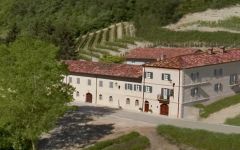Marcarini Barolo Brunate (375ML half-bottle) 2007
-
Robert
Parker -
Wine
Enthusiast -
Wine
Spectator


Product Details
Your Rating
Somm Note
Winemaker Notes
Professional Ratings
-
Robert Parker's Wine Advocate
The estate's 2007 Barolo Brunate sweeps across the palate with endless layers of expansive fruit. The Brunate shows fabulous intensity and depth in an uncharacteristically rich, opulent style for Marcarini. Despite the wine's richness there is plenty of Brunate character, particularly on the finish, where menthol, pine, resin, spices and a host of other balsamic notes speak with great eloquence. Marcarini harvested Brunate on September 24 and 25. The wine saw 15 days of fermentation, followed by another 42 days of contact with the skins. The wine then spent two years in large, neutral casks prior to being racked into steel to rest before being bottled. Anticipated maturity: 2017-2027.
These are some of the finest Baroli I have ever tasted from Marcarini and proprietor Manuel Marchetti. The warmth of the vintage has given the wines an extra level of generosity in the fruit that acts as a wonderful counterpoint to the firm tannins that are generally present in this estate’s young Baroli.
-
Wine Enthusiast
Barolo from the Brunate cru shows gorgeous characteristics of mature fruit, spice, natural rubber, asphalt, tar and root beer. The wine’s personality is marked by a comforting, almost familiar territorydriven feel that recalls the greatest Nebbiolo-based wines from Piedmont. Save this bottle in your cellar for 10 years or more.
-
Wine Spectator
This is slightly herbal, sporting cherry and strawberry flavors as well. A taut, linear red, with tension and a firmly tannic finish. A bit compact now, but with good potential. Best from 2015 through 2030.
Other Vintages
2018-
James
Suckling
-
James
Suckling -
Wine
Enthusiast -
Wine &
Spirits
-
Wine
Enthusiast -
Wine
Spectator
-
Wine
Enthusiast -
James
Suckling -
Wine &
Spirits -
Wine
Spectator
-
Wine
Spectator - Decanter
-
Wine
Enthusiast
-
Wine
Enthusiast -
Wine
Spectator
-
James
Suckling -
Wine
Enthusiast -
Wine &
Spirits -
Robert
Parker -
Wine
Spectator
-
Wine
Spectator -
Wine
Enthusiast -
James
Suckling -
Robert
Parker
-
Robert
Parker
-
Wine
Enthusiast -
Robert
Parker
-
Robert
Parker
-
Wine
Spectator
-
Wine
Spectator
-
Wine
Spectator




Luisa & Manuel Marchetti have been in charge of Luisa's family winery since 1990, with Manuel responsible for sales & promotions, Luisa orchestrating the wines with consultant oenologist Armando Cordero. Founded by Luisa's great-great-great-grandfather, the estate was one of the very first in the area to designate single vineyards on its labels as early as 1950. The property covers 62 acres, 42 of which are under vine. In fact, one of Marcarini's superb, historical crus is 150-year-old Boschi di Berri, whose Dolcetto vines are among the oldest in Italy, having survived Phylloxera and maintained indigenous rootstock. The Marchettis' varietal map (except the Shiraz) is almost exclusively native to the Langhe hills. The Nebbiolo grapes for Barolo are grown within the estate's original nucleus, high on the rolling terroir of La Morra: two celebrated, contiguous crus, Brunate and La Serra. The building itself (adjoining a medieval tower) goes back to the 1700s: the cool, ancient underground cellars provide an ideal environment for the wines’ classic élevage. The exceptional vineyards – all estate-owned – are the true heart of the winery. The superb locations, steepness of the slopes and nature of the terrain, exposure to the sunlight, exceptional microclimate, are not only conducive to top wines, but to non-aggressive, natural vineyard management.

Responsible for some of the most elegant and age-worthy wines in the world, Nebbiolo, named for the ubiquitous autumnal fog (called nebbia in Italian), is the star variety of northern Italy’s Piedmont region. Grown throughout the area, as well as in the neighboring Valle d’Aosta and Valtellina, it reaches its highest potential in the Piedmontese villages of Barolo, Barbaresco and Roero. Outside of Italy, growers are still very much in the experimentation stage but some success has been achieved in parts of California. Somm Secret—If you’re new to Nebbiolo, start with a charming, wallet-friendly, early-drinking Langhe Nebbiolo or Nebbiolo d'Alba.

The center of the production of the world’s most exclusive and age-worthy red wines made from Nebbiolo, the Barolo wine region includes five core townships: La Morra, Monforte d’Alba, Serralunga d’Alba, Castiglione Falletto and the Barolo village itself, as well as a few outlying villages. The landscape of Barolo, characterized by prominent and castle-topped hills, is full of history and romance centered on the Nebbiolo grape. Its wines, with the signature “tar and roses” aromas, have a deceptively light garnet color but full presence on the palate and plenty of tannins and acidity. In a well-made Barolo wine, one can expect to find complexity and good evolution with notes of, for example, strawberry, cherry, plum, leather, truffle, anise, fresh and dried herbs, tobacco and violets.
There are two predominant soil types here, which distinguish Barolo from the lesser surrounding areas. Compact and fertile Tortonian sandy marls define the vineyards farthest west and at higher elevations. Typically the Barolo wines coming from this side, from La Morra and Barolo, can be approachable relatively early on in their evolution and represent the “feminine” side of Barolo, often closer in style to Barbaresco with elegant perfume and fresh fruit.
On the eastern side of the Barolo wine region, Helvetian soils of compressed sandstone and chalks are less fertile, producing wines with intense body, power and structured tannins. This more “masculine” style comes from Monforte d’Alba and Serralunga d’Alba. The township of Castiglione Falletto covers a spine with both soil types.
The best Barolo wines need 10-15 years before they are ready to drink, and can further age for several decades.
